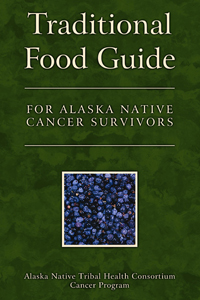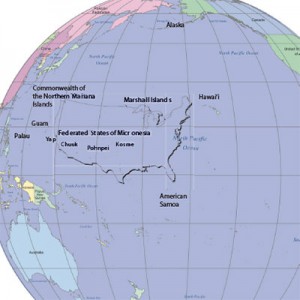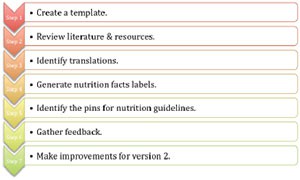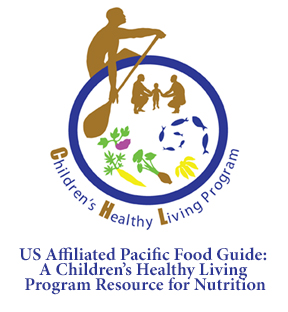
The Pacific Food Guide was inspired by the excellent resource on traditional foods for Alaska Natives, the Traditional Food Guide for Alaska Native Cancer Survivors. This resource brilliantly combines traditional knowledge of Alaska Native foods with nutrition facts. A comprehensive resource similar to this did not exist for Native Hawaiians and Pacific Islanders of the United States Affiliated Pacific Islands (USAPI). Although the diversity and expansiveness of the region makes this a monumental task, a food guide that reflects the traditional foods of American Samoa, Guam, the Commonwealth of the Northern Mariana Islands (CNMI), the Republic of the Marshall Islands (RMI), the Republic of Palau, the Federated States of Micronesia (FSM), and Hawai‘i was needed.
The Pacific Food Guide was developed by the Children’s Healthy Living Program (CHL) for Remote and Underserved Minorities of the Pacific Region. CHL is a partnership among the remote Pacific jurisdictions of Alaska, American Samoa, CNMI, RMI, the Republic of Palau, FSM, Guam, and Hawai‘i to study child obesity among Pacific children, ages 2-8 years. The program is sponsored by the United States Department of Agriculture (USDA), Agriculture and Food Research Initiative Grant no 2011-68001-30335. To address the child obesity epidemic in the Pacific, the CHL partners have identified the following program objectives: 1) Conduct program/data inventories and situational analysis; 2) Train 22 professionals and paraprofessionals in obesity prevention; 3) Develop a Pacific food, nutrition, and physical activity data management and evaluation system; 4) Develop and conduct a community-based environmental intervention to prevent, maintain, or reduce young child overweight and obesity; 5) Evaluate the environmental intervention; and 6) Incur at least one obesity prevention policy change per jurisdiction. CHL’s Pacific Food Guide contributes to CHL’s objective to train a Pacific obesity prevention workforce.

Map of the Pacifi c Region indicating locations of Hawai‘i, the U.S. Affi liated Pacifi c Islands (American Samoa, Commonwealth of the Northern Mariana Islands, Federated States of Micronesia, Guam, Republic of the Marshall Islands, and the Republic of Palau), Alaska, and the contiguous U.S. The overlay of the contiguous U.S., set between Hawai‘i and Guam, indicates that the width of the contiguous U.S. at its widest point, is just 400 miles short of the distance between these two Pacifi c islands.
The primary purpose of developing the Pacific Food Guide was to serve as a resource for students enrolled in one section of the Food Science and Human Nutrition 185 (FSHN 185): The Science of Human Nutrition introductory nutrition course offered through the University of Hawai‘i Outreach College. This specific section was unique as the curriculum was modified to incorporate the foods and practices of the USAPI in the traditional introductory nutrition course material. The secondary purpose was to present to readers an exploration of the traditional foods of the USAPI exhibiting both the diversity and commonality of the cultures of the region. In addition, we want readers to be able to establish a connection between the foods of the USAPI and nutrient guidelines from the United States Department of Agriculture (USDA) and the Secretariat of the Pacific Community (SPC). The long-term goal is to produce a resource that increases access to nutrition information for the USAPI.
We hope that the features of the Guide help readers to connect the traditional foods of the USAPI with concepts of nutrition. It is an ever-evolving resource and will get better and better over time. We encourage you to contact us with your ideas and content.
Developing the Pacific Food Guide:
the Children’s Healthy Living Program Resource for Nutrition
A multi-step process was used to develop the Guide. First, an outline template was created as a guide to list foods from the United States Affiliated Pacific USAP. To reflect the uniqueness of the region, the template was organized into three neutral categories: Walks along the Ground (e.g., animals), Chosen from the Sea (e.g., seafood), and Grown from the Ground (e.g., plants). Each food item includes the scientific name(s) and the common name in English and the various languages of the region. Brief descriptions on the physical appearance, preparation, and nutrition facts of the foods are also noted, as modeled by the Traditional Food Guide for Alaska Native Cancer Survivors resource. Additionally, selection and storage information are provided.
Second, a review of the resources available on the foods of the USAP, which includes books, booklets, pamphlets, textbooks, and websites, was conducted to identify foods that fit into each of the three categories. The goal of the Guide is to provide brief but comprehensive information with all information about a single food item presented on one page to make it easy for navigation. However, some foods with similar characteristics were grouped together such as citrus fruits and the parrotfish family. Pictures were also identified for each food item using open source and original photographs from CHL staff and affiliates.

Figure 1. Diagram outlining the steps used to create the Pacific Food Guide: the Children’s Healthy Living Program Resource for Nutrition.
Third, to reflect the rich culture of languages in the USAP, the CHL network was used to identify the traditional names (i.e., language translations) of the foods included in the Guide. The CHL network comprises native peoples from the all USAP jurisdictions in addition to academic and cultural experts. Individuals who spoke one or more of the languages in the USAP were identified and asked to provide translations of all foods they were familiar with in their native language. This is a very important aspect of the Guide as this will ensure readers can identify a food item even if they do not know its English or scientific name. Any named translations for food items received from the CHL network were included along with food name translations found in the published literature and native language dictionaries available online.
Fourth, a nutrition facts label was created for each food based on existing food and nutrient databases and composition tables. This included the USDA Nutrient Data Laboratory, Hawai’i Foods Database, Hawai’i Seafood Council, and the Food and Agricultural Organization of the United Nations Library. The label was designed using the Genesis® R&D SQL Version 9.9.2.0 Product Development and Labeling Software, which is the commercial-grade food composition and nutrient analysis software from Elizabeth Steward Hands and Associates (ESHA) Research. Serving sizes were determined based on Nutritional Labeling and Education Act (NLEA) standards. These labels reflect the macronutrient and micronutrient highlights for each food item.
Fifth, in order to weave in the nutrition guidelines, a set of “pins” was created for both the USDA and SPC food and nutrient guidelines. The USDA and SPC pins reflect each organization’s classification of food groups, and each food was given pins in accordance with both USDA and SPC guidelines. This feature allows the reader to see where each food fits within the food and nutrition guidelines from both organizations.
For the initial version, all information and features were formatted into a Portable Document File (pdf) that simulated an online book. This version was used for instruction of the Fall 2013 section of Food Science and Human Nutrition (FSHN) 185: The Science of the Human Nutrition modified for the Pacific taught through the University of Hawai‘i Outreach College. Students’ perception on appropriateness of the Guide to instruct the class was assessed through survey. In addition, the complete file was emailed throughout the CHL network along with an online survey to evaluate content of the Guide and gather feedback. All comments, questions, and feedback were collected to guide the production of Version 2 of the Pacific Food Guide.



